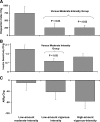Effects of exercise training intensity on pancreatic beta-cell function
- PMID: 19592624
- PMCID: PMC2752909
- DOI: 10.2337/dc09-0032
Effects of exercise training intensity on pancreatic beta-cell function
Abstract
Objective: Insulin resistance and beta-cell dysfunction both are important contributors to the pathogenesis of type 2 diabetes. Exercise training improves insulin sensitivity, but its effects on beta-cell function are less well studied.
Research design and methods: Sedentary, overweight adults were randomized to control or one of three 8-month exercise programs: 1) low amount/moderate intensity, 2) low amount/vigorous intensity, or 3) high amount/vigorous intensity. Of 387 randomized, 260 completed the study and 237 had complete data. Insulin sensitivity (S(i)), acute insulin response to glucose (AIRg), and the disposition index (DI = S(i) x AIRg) were modeled from an intravenous glucose tolerance test.
Results: Compared with control subjects, all three training programs led to increases in DI. However, the moderate-intensity group experienced a significantly larger increase in DI than either of the vigorous-intensity groups and through a different mechanism. The high-amount/vigorous-intensity group improved S(i) and had a compensatory reduction in AIRg, whereas the moderate-intensity group had a similar improvement in S(i) but almost no reduction in AIRg. Importantly, the inactive control group experienced a significant increase in fasting glucose.
Conclusions: To the extent that the DI accurately reflects beta-cell function, we observed that both moderate- and vigorous-intensity exercise training improved beta-cell function, albeit through distinct mechanisms. It is not clear which of these mechanisms is preferable for maintenance of metabolic health. While moderate-intensity exercise led to a larger improvement in DI, which may reflect a transition toward a more normal DI, longer-term investigations would be necessary to determine which was more effective at reducing diabetes risk.
Trial registration: ClinicalTrials.gov NCT00200993.
Figures

Comment in
-
Effects of exercise training intensity on pancreatic {beta}-cell function: response to Slentz et al.Diabetes Care. 2010 Mar;33(3):e45. doi: 10.2337/dc09-1981. Diabetes Care. 2010. PMID: 20190293 No abstract available.
References
-
- Kahn S, Hull R, Utzschneider K: Mechanisms linking obesity to insulin resistance and to type 2 diabetes. Nature 2006; 444: 840– 846 - PubMed
-
- Ferrannini E, Gastaldelli A, Miayzaki Y, Matsuda M, Pettiti M, Natali A, Mari A, DeFronzo R: Predominant role of reduced beta-cell sensitivity to glucose over insulin resistance in impaired glucose tolerance. Diabetologia 2003; 46: 1211– 1219 - PubMed
-
- Bergman R: Banting Lecture 2006: Orchestration of glucose homeostasis: from a small acorn to the California Oak. Diabetes 2007; 56: 1489– 1500 - PubMed
-
- Stumvoll M, Tataranni P, Bogardus C: The hyperbolic law: a 25-year perspective. Diabetologia 2005; 48: 207– 209 - PubMed
-
- Bergman R, Finegood D, Ader M: Assessment of insulin sensitivity in vivo. Endocr Rev 1985; 6: 45– 86 - PubMed

